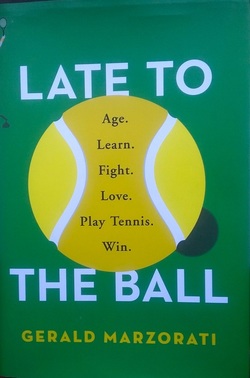
There was one paragraph in Gerald Marzorati's interesting book Late to the Ball that was worth the price of it. The paragraph contained the excellent phrase "the healthy aloneness of singles tennis." Marzorati sees in it affinities with reading, which is what he calls his "life pursuit." Being that he was an editor at the New York Times Magazine, Harper's, and The New Yorker, he has done a special kind of reading. As a writer, he has done the same. And so have I. So that explains to me, at least in part, why I have pursued tennis, specifically singles, and why it has meshed so well with my own "life pursuit," and conversely why I have always felt uncomfortable playing doubles. Even when (on those rare occasions) I am having fun at doubles, I don't get out of it what I get out of singles. And I would not have pursued tennis so relentlessly if doubles was all that I had played.
As for the rest of the book, it was a good idea well executed, but in the end, a disappointment for not going very deep. Maybe it should have been just a long magazine article, like the kind he helped other writers develop all those many years. Still, as I said in my opening, it was an interesting book, and will go on my bookshelf along with many other titles on the subject of tennis, including favorites like John McPhee's Levels of the Game, Andre Agassi's Open, and even Brad Gilbert's Winning Ugly. As it happens, what started it all for me in this sport was a book, Timothy Gallwey's The Inner Game of Tennis, which I initially read to help me with my writing. This was in the late 1970s, long before I had picked up a racquet with any serious ambition. Recommended to me by a pianist friend, Haskell "Hal" Small, to whom it had been recommended by an opera-singer friend of his, it turned out to be one of the most important books I have ever read -- on any subject. To this day, I return to it for inspiration both on and off the court.
As for the rest of the book, it was a good idea well executed, but in the end, a disappointment for not going very deep. Maybe it should have been just a long magazine article, like the kind he helped other writers develop all those many years. Still, as I said in my opening, it was an interesting book, and will go on my bookshelf along with many other titles on the subject of tennis, including favorites like John McPhee's Levels of the Game, Andre Agassi's Open, and even Brad Gilbert's Winning Ugly. As it happens, what started it all for me in this sport was a book, Timothy Gallwey's The Inner Game of Tennis, which I initially read to help me with my writing. This was in the late 1970s, long before I had picked up a racquet with any serious ambition. Recommended to me by a pianist friend, Haskell "Hal" Small, to whom it had been recommended by an opera-singer friend of his, it turned out to be one of the most important books I have ever read -- on any subject. To this day, I return to it for inspiration both on and off the court.
 RSS Feed
RSS Feed
